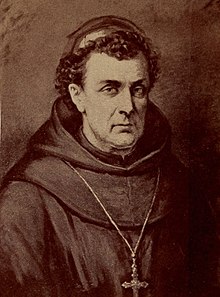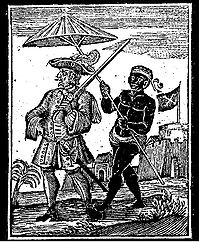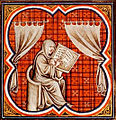Portal:Biography
The Biography Portal
A biography, or simply bio, is a detailed description of a person's life. It involves more than just basic facts like education, work, relationships, and death; it portrays a person's experience of these life events. Unlike a profile or curriculum vitae (résumé), a biography presents a subject's life story, highlighting various aspects of their life, including intimate details of experience, and may include an analysis of the subject's personality.
Biographical works are usually non-fiction, but fiction can also be used to portray a person's life. One in-depth form of biographical coverage is called legacy writing. Works in diverse media, from literature to film, form the genre known as biography.
An authorized biography is written with the permission, cooperation, and at times, participation of a subject or a subject's heirs. An autobiography is written by the person themselves, sometimes with the assistance of a collaborator or ghostwriter. (Full article...)
Featured biographies –
Honório Hermeto Carneiro Leão, Marquis of Paraná (11 January 1801 – 3 September 1856) was a Brazilian politician, diplomat, judge and monarchist. Paraná was born to a noble family in São Carlos do Jacuí, in what was then the captaincy of Minas Gerais. After attending the University of Coimbra in Portugal and having returned to Brazil, Paraná was appointed a judge in 1826 and later elevated to appellate court justice. In 1830, he was elected to represent Minas Gerais in the Chamber of Deputies; he was re-elected in 1834 and 1838, and held the post until 1841.
In the aftermath of emperor Pedro I's abdication in 1831, a regency created to govern Brazil during the minority of the former emperor's son, Pedro II, soon dissolved into chaos. Paraná formed a political party in 1837 that became known as the Reactionary Party, which evolved into the Party of Order in the early 1840s and in the mid-1850s into the Conservative Party. He and his party's stalwart and unconditional defence of constitutional order allowed the country to move beyond a regency plagued by factious disputes and rebellions that might easily have led to a dictatorship. Appointed president of Rio de Janeiro Province in 1841, Paraná helped put down a rebellion headed by the opposition Liberal Party the following year. Also in 1842, he was elected senator for Minas Gerais and appointed by Pedro II to the Council of State. In 1843, he became the de facto first president (prime minister) of the Council of Ministers, but resigned after a quarrel with the emperor. (Full article...)
James Arthur Lovell Jr. (/ˈlʌvəl/ LUV-əl; born March 25, 1928) is an American retired astronaut, naval aviator, test pilot and mechanical engineer. In 1968, as command module pilot of Apollo 8, he became, with Frank Borman and William Anders, one of the first three astronauts to fly to and orbit the Moon. He then commanded the Apollo 13 lunar mission in 1970 which, after a critical failure en route, looped around the Moon and returned safely to Earth.
A graduate of the United States Naval Academy in Annapolis, Maryland, in the class of 1952, Lovell flew F2H Banshee night fighters. This included a Western Pacific deployment aboard the aircraft carrier USS Shangri-La. In January 1958, he entered a six-month test pilot training course at the Naval Air Test Center at Naval Air Station Patuxent River, Maryland, with Class 20 and graduated at the top of the class. He was then assigned to Electronics Test, working with radar, and in 1960 he became the Navy's McDonnell Douglas F-4 Phantom II program manager. The following year he became a flight instructor and safety engineering officer at Naval Air Station Oceana in Virginia Beach, Virginia, and completed Aviation Safety School at the University of Southern California. (Full article...)
August Edler von Meyszner (3 August 1886 – 24 January 1947) was an Austrian Gendarmerie officer, right-wing politician, and senior Ordnungspolizei (order police) officer who held the post of Higher SS and Police Leader in the German-occupied territory of Serbia from January 1942 to March 1944, during World War II. He has been described as one of Reichsführer-SS Heinrich Himmler's most brutal subordinates.
Meyszner began his career as an officer in the Gendarmerie, served on the Italian Front during World War I and reached the rank of Major der Polizei by 1921. He joined the Austrian Nazi Party in September 1925 and became a right-wing parliamentary deputy and provincial minister in the Austrian province of Styria in 1930. Due to his involvement with the Nazis, Meyszner was forcibly retired in 1933 and arrested in February 1934, but released after three months at the Wöllersdorf concentration camp. That July, he was rearrested following an attempted coup, but escaped police custody and fled to Nazi Germany, where he joined the Ordnungspolizei (Orpo) and then the Allgemeine SS. After police postings in Austria, Germany and occupied Norway, Himmler appointed Meyszner as Higher SS and Police Leader in Serbia in early 1942. He was one of few Orpo officers to be appointed to such a role. (Full article...)
General Sir Henry George Chauvel, GCMG, KCB (16 April 1865 – 4 March 1945) was a senior officer of the Australian Imperial Force who fought at Gallipoli and during the Sinai and Palestine Campaign in the Middle Eastern theatre of World War I. He was the first Australian to attain the rank of lieutenant general and later general, and the first to lead a corps. As commander of the Desert Mounted Corps, he was responsible for one of the most decisive victories and fastest pursuits in military history.
The son of a grazier, Chauvel was commissioned as a second lieutenant in the Upper Clarence Light Horse, a unit organised by his father, in 1886. After the family moved to Queensland he was commissioned as a second lieutenant in the Queensland Mounted Infantry in 1890, and saw service during the 1891 Australian shearers' strike. He became a regular officer in 1896, and went to the United Kingdom as part of the Queensland contingent for the 1897 Diamond Jubilee of Queen Victoria. In 1899 he commanded one of two companies of Queensland Mounted Infantry that were Queensland's initial contribution to the Boer War. After the war, he was closely involved with the training of the Australian Light Horse. (Full article...)
Mariah Carey (/məˈraɪə/; born March 27, 1969) is an American singer, songwriter, record producer, and actress. An influential figure in music, she is known for her five-octave vocal range, melismatic singing style and signature use of the whistle register. Referred to as the "Songbird Supreme" by Guinness World Records, she was ranked as the fifth greatest singer of all time by Rolling Stone in 2023.
Carey rose to fame in 1990 with her self-titled debut album and became the only artist to have their first five singles reach number one on the US Billboard Hot 100 chart. She achieved an international success with the best-selling albums Music Box (1993) and Daydream (1995), before adopting a new urban image with hip hop-inflected sounds, following the release of Butterfly (1997). With eleven consecutive years of US number-one singles, Billboard ranked Carey as the most successful artist of the decade. Following a career decline and the failure of her 2001 film Glitter, she returned to the top of the charts with The Emancipation of Mimi (2005), one of the best-selling albums of the 21st century. (Full article...)

Michael Francis Egan OFM (September 29, 1761 – July 22, 1814) was an Irish American Catholic prelate who served as Bishop of Philadelphia from 1808 until his death.
Egan was born in Ireland in 1761, and joined the Franciscan Order at a young age. He served as a priest in Rome, Ireland, and Pennsylvania and became known as a gifted preacher. In 1808, Egan was appointed the first Bishop of Philadelphia. Egan's tenure as bishop saw the construction of new churches and the expansion of the Catholic Church membership in his diocese, but much of his time was consumed by disputes with the lay trustees of his pro-cathedral, St. Mary's Church in Philadelphia. He died in Philadelphia, probably of tuberculosis, in 1814. (Full article...)

John William Beschter SJ (born Johann Wilhelm Beschter; German: [ˈjoːhan ˈvɪlhɛlm ˈbɛʃtɐ]; May 20, 1763 – January 6, 1842) was a Catholic priest and Jesuit from the Duchy of Luxembourg in the Austrian Netherlands. He emigrated to the United States as a missionary in 1807, where he ministered in rural Pennsylvania and Maryland. Beschter was the last Jesuit pastor of St. Mary's Church in Lancaster, as well as the pastor of St. John the Evangelist Church in Baltimore, Maryland. He was also a priest at several other German-speaking churches in Pennsylvania.
Beschter's ministerial work was punctuated by a time as master of novices at the new Jesuit novitiate at White Marsh Manor, as well as a brief term as president of Georgetown College in 1829. While in Maryland, he aligned himself with the Continental European Jesuits in the United States, who endorsed a monarchist view of ecclesiastical leadership. After his presidency, Beschter remained at Georgetown for a year as a professor of German, before returning to Paradise, Pennsylvania, where he lived out the last twelve years of his life as a priest. (Full article...)

Jethro Exum Sumner (c. 1733 – c. March 18, 1785) was a senior officer of the Continental Army during the American Revolutionary War. Born in Virginia, Sumner's military service began in the French and Indian War as a member of the state's Provincial forces. After the conclusion of that conflict, he moved to Bute County, North Carolina, where he acquired a substantial area of land and operated a tavern. He served as Sheriff of Bute County, but with the coming of the American Revolution, he became a strident patriot, and was elected to North Carolina's Provincial Congress.
Sumner was named the commanding officer of the 3rd North Carolina Regiment of the North Carolina Line, a formation of the Continental Army, in 1776, and served in both the Southern theater and Philadelphia campaign. He was one of five brigadier generals from North Carolina in the Continental Army, in which capacity he served between 1779 and 1783. He served with distinction in the battles of Stono Ferry and Eutaw Springs, but recurring bouts of poor health often forced him to play an administrative role, or to convalesce in North Carolina. Following a drastic reduction in the number of North Carolinians serving with the Continental Army, Sumner became a general in the state's militia but resigned in protest after the North Carolina Board of War awarded overall command of the militia to William Smallwood, a Continental Army general from Maryland. At the end of the war in 1783, Sumner helped to establish the North Carolina Chapter of the Society of the Cincinnati, and became its first president. He died in 1785 with extensive landholdings and 35 slaves. (Full article...)
Learie Nicholas Constantine, Baron Constantine (21 September 1901 – 1 July 1971) was a Trinidadian cricketer, lawyer and politician who served as Trinidad and Tobago's High Commissioner to the United Kingdom and became the UK's first black peer. He played 18 Test matches for the West Indies before the Second World War and took the team's first wicket in Test cricket. An advocate against racial discrimination, in later life he was influential in the passing of the 1965 Race Relations Act in Britain. He was knighted in 1962 and made a life peer in 1969.
Born in Trinidad, Constantine established an early reputation as a promising cricketer, and was a member of the West Indies teams that toured England in 1923 and 1928. Unhappy at the lack of opportunities for black people in Trinidad, he decided to pursue a career as a professional cricketer in England, and during the 1928 tour was awarded a contract with the Lancashire League club Nelson. He played for the club with distinction between 1929 and 1938, while continuing as a member of the West Indies Test team in tours of England and Australia. Although his record as a Test cricketer was less impressive than in other cricket, he helped to establish a uniquely West Indian style of play. He was chosen as one of the Wisden Cricketers of the Year in 1939. (Full article...)















































